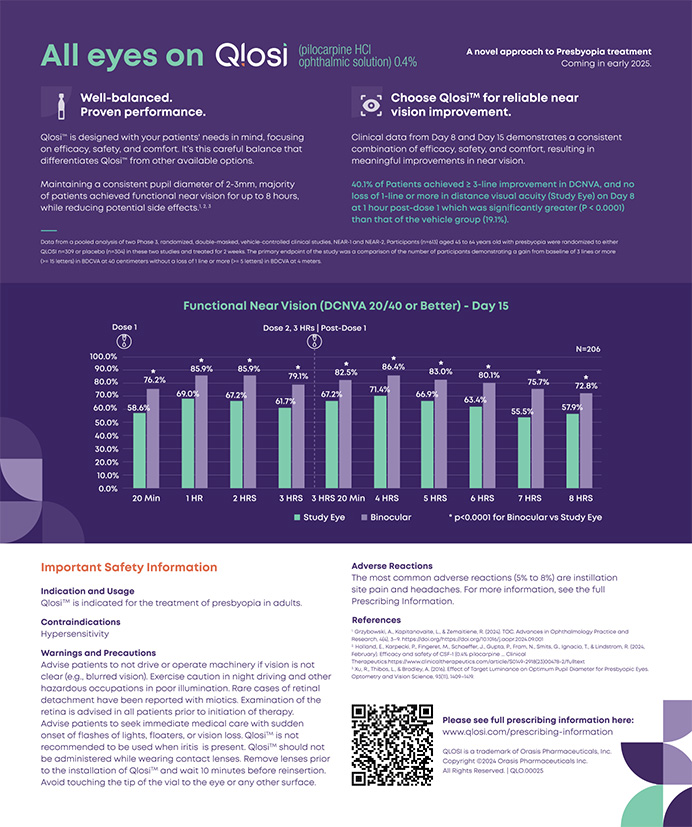For the past 5 years, my associates and I have been working with ultrasmall-incision cataract surgery, focusing the efforts of our clinical trials on low intraocular energy usage and the creation of smaller incisions for both cataract extraction and IOL implantation. We were the first team in the world to break the 2-mm incision barrier in cataract surgery with the implantation of a prefolded, dehydrated acrylic IOL by Acri.Tec (Berlin, Germany) upon the completion of a bimanual cataract extraction with the Dodick Photolysis Nd:YAG system (A.R.C. Laser Corp., Salt Lake City, UT).1
The initial interest in “phaco lasers” prompted significant research and development from phacoemulsification technology manufacturers, efforts directed primarily at decreasing energy levels and incision sizes. Procedures performed through smaller incisions have frequently resulted in reduced postoperative astigmatic induction, decreased corneal nerve damage, less tissue manipulation, and, therefore, a smaller amount of endothelial cell loss in the cornea surrounding the incision, as well as less postoperative inflammation. Accordingly, we have seen the emergence of an entire new line of systems, commonly called “cold phacos,” which are designed to address these principles. When WhiteStar (AMO, Santa Anna, CA) became available in the European Union in April of this year, we began to conduct clinical trials using the technology in a bimanual fashion with 1.4-mm incisions, and our initial experience has been quite rewarding in terms of efficacy, safety, and operative time.
Since January of this year, we have been implanting the ThinOptX IOL (ThinOptX, Abingdon, VA), a lens that can be folded and implanted through sub–1.6-mm incisions. Once we completed our initial bimanual use of the WhiteStar system through 1.4-mm incisions, it came as a natural subsequent step to perform phacoemulsification and IOL implantation through an incision of this size.
CASE STUDY
A 47-year-old white male presented with preoperative visual acuity of 20/50 in the right eye and light perception in the left. His right eye also showed both a +1 nuclear sclerotic cataract and moderate diabetic retinopathy, and his left eye showed a +2 to +3 nuclear sclerotic cataract (on a scale of 1 to 4), as well as proliferative diabetic retinopathy with vitreous hemorrhage.
We decided to perform phacoemulsification and implant an IOL through the clear cornea, using trypan blue as an aid to visualize the capsulorhexis. The procedure was performed in our outpatient ophthalmic ambulatory surgical facility, within the MITERA General Hospital in Athens, Greece. We applied 2% Xylocaine gel (AstraZeneca International, London, England) preoperatively for 10 minutes, and performed the procedure through two 1.4-mm incisions, which we made with a 2.5-mm disposable keratome blade (Alcon Laboratories, Fort Worth, TX), advanced to an effective 1.3- to 1.4-mm internal lip incision. The incision created has a trapezoid appearance with a wider external lip, which aids in the corneal tissue tears that can occur with intraoperative manipulations. Following the capsulorhexis, we performed hydrodissection, inserting the WhiteStar phaco probe through one incision, and the irrigation/nucleus manipulator probe through the other (Figure 1A).
We used our standard stop-and-chop technique to perform phacoemulsification, completing the process in 1 minute, 35 seconds (Figure 1B). After I/A, we filled the capsular bag with Healon (Pharmacia Corporation, Peapack, NJ). Next, we folded the IOL using warm (45ºC) BSS (Alcon Laboratories, Fort Worth, TX) (Figure 2A), and implanted it through the original 1.4-mm incision using a ThinOptX folding set (Geuder AG, Heidelberg, Germany) (Figure 2B). The surgeon should implant the ThinOptX IOL with the steps of the optic facing anteriorly, which is established by direct visualization upon implantation and unfolding (which is immediate). If necessary, the lens can be flipped within the anterior chamber for correct placement. After implanting the lens, we removed the viscoelastic using I/A, and slightly hydrated the wounds with BSS to ensure that they were watertight. The entire unilateral procedure lasted 6 minutes, 45 seconds.
To address the patient's proliferative diabetic retinopathy, my associate, Giannis Stavrakas, MD, performed a pars plana vitrectomy and endophotocoagulation on the same day, but only in the operated eye. At his 1-month postoperative follow-up examination, the patient's visual acuity was 20/40, his cornea remained clear, his anterior chamber was quiet, and the IOL remained centered within the capsular bag.
CONCLUSION
Although cataract surgery performed with phacoemulsification is one of the safest and most effective procedures in medicine, there has been increasing interest in creating smaller incisions with the goal of performing true endocapsular cataract removal. Preserving the entire capsular bag could allow for the possibility of using injectable materials to act as an IOL by filling the capsular bag and retaining accommodation. Recent laboratory animal studies have shown that this is a possibility. Phacoemulsification probes have been limited to a certain diameter because of the necessary cooling sleeve that accompanies the ultrasound needle. However, with the development of WhiteStar technology, this is no longer necessary. Several surgeons have attempted to perform phacoemulsification through a smaller incision using standard technology without a sleeve, but this could prove to be traumatic to the cornea, because the tissue surrounding the incision is subject to substantial thermal injury.
We have found that the WhiteStar combines all of the advantages of small incisions and low energy usage with familiar techniques, short operative time, and the ability to operate on cataracts of any nuclear density. The ThinOptX IOL complements this technology, allowing the surgeon to retain the ultrasmall incision.
A. John Kanellopoulos, MD, is a refractive surgery and corneal and external disease specialist in private practice in Athens, Greece, and is an Associate Professor of Ophthalmology at New York University Medical School, New York, NY. He has no financial interest in any of the products mentioned herein. Dr. Kanellopoulos may be reached at (917) 770-0586; laservision@internet.gr
1. Kanellopolous AJ: Laser cataract surgery: A prospective evaluation of 1,000 laser cataract procedures using the Dodick Photolysis Nd:YAG system. Ophthalmology 108:649-655, 2001


